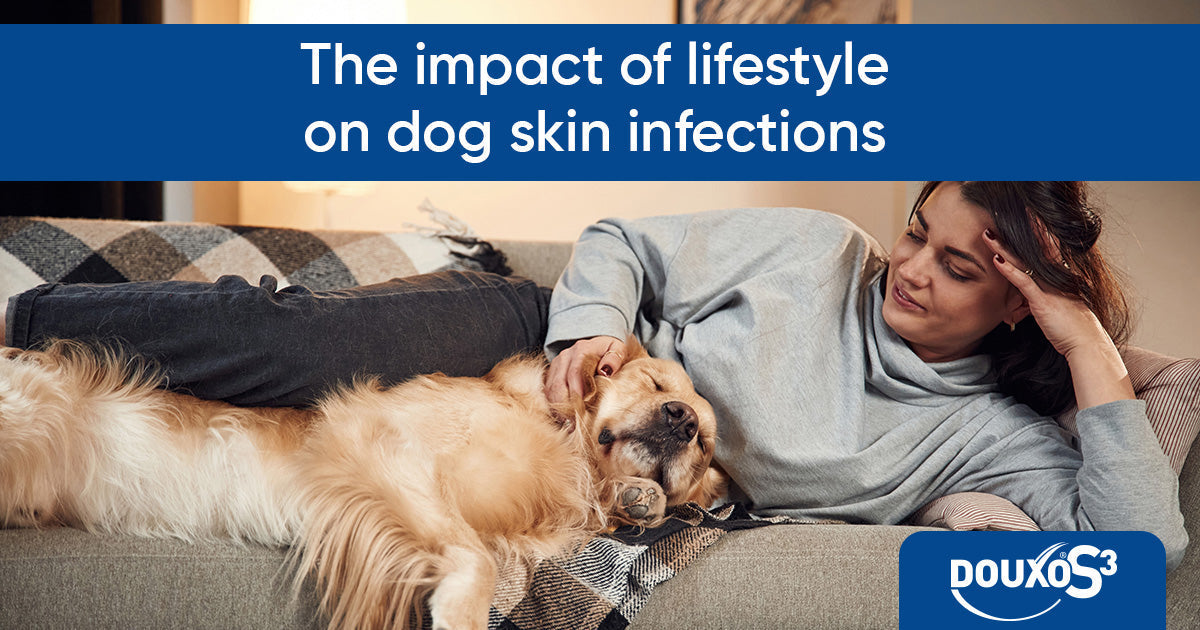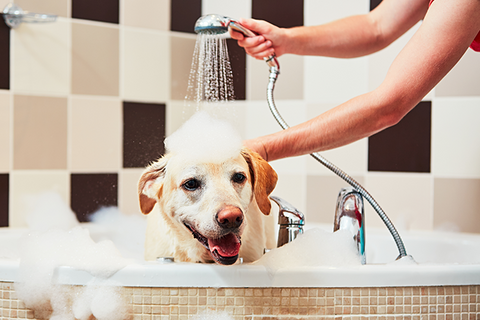
The impact of lifestyle on dog skin infections
Dogs are part of our lives. Wherever we go, they come with us. They share our routines, our hobbies, and of course, our lifestyle: urban or rural, sporty or mostly quiet, they adapt and enjoy any time they spend with us. Unfortunately, as part of the deal, they also share some of the risk factors that contribute to debilitating the skin. Understanding why dogs get skin infections -apparently out of the blue- can be essential to manage them. Most infections are mild and can be overcome easily with early veterinary treatment. However, sometimes they can be severe, debilitating, and challenging to treat, so it is worth discovering more about them.
Skin infection or “pyoderma”
Your vet may refer to your dog’s skin infection as pyoderma (from the Greek “pyos”= pus, and derma = skin). Pyoderma is a bacterial skin infection commonly caused by Staphylococcus pseudintermedius. This bug is also present on healthy dogs' skin, in delicate balance with other bacteria, fungi, and parasites (yes! You cannot imagine what fauna dogs and people harbor in the skin!). When there is a chance, because the skin is imbalanced, the Staphylococcus proliferates and causes disease.
The undesirable growth of this bug is most often secondary to an underlying disease. This means, it is important to remember that there is usually more going on than just the signs you can see on the surface! For treatment to be successful in the long term, any underlying process needs to be identified. Otherwise, your dog’s infections will keep recurring, even after an initially successful management!
There are 3 different types of pyoderma:
Surface pyoderma
Surface pyoderma is the most superficial type of pyoderma, as only the outer epidermal layers of the skin are affected. It is most commonly seen as hot spots (LINK TO THE SPECIFIC BLOG ENTRY) , caused by either parasites, self-trauma or intertrigo, a skin fold dermatitis common in brachycephalic dogs with excess skin folds.
Superficial Pyoderma
Superficial pyoderma is a deeper skin infection that also affects part of the hair follicle, commonly causing folliculitis and a range of skin signs including pus-filled pustules, inflamed papules, crusting and hair loss. Often, folliculitis occurs secondary to allergic skin disease, parasites, and hormonal conditions.
Deep pyoderma
Deep pyoderma can affect all layers of the skin, even down to the subcutaneous layer. It can be intensely itchy and painful, and dogs may develop ulcerations, drainage tracts and discharge. Short hair dog breeds are vulnerable to developing deep pyoderma caused by traumatising high friction areas, such as the skin over the elbows on hard floors, which leads to a painful condition called callus pyoderma.
Why is pyoderma so common in dogs?
Anything that allows the infection to become established on or in the skin can lead to pyoderma – for example, parasites, cuts, or grazes. Other diseases that weaken or inhibit the immune system or normal skin growth can also be risk factors, such as Cushing’s Disease, Hypothyroidism, or immunosuppressive drugs like steroids or chemotherapy. However, the most common reasons are due to skin irritation and allergies. And overall, these risks are heavily influenced by your dog’s lifestyle!
Wild or feral vs domestic dogs
It’s nice to idealize wildlife and think that wild dogs have naturally healthy skin, and only our domestic dogs have to deal with more skin problems. But it’s not all that simple. In particular, wild and feral dogs have a higher incidence of parasites, and mange (Sarcoptes scabeii infestation) is very common. The lesions from parasite bites are a common trigger for pyoderma: the poor mangy feral dogs we sometimes see on the news or in rescue charities remind us that effective parasite control is essential for good skin health.
In addition, wild and feral dogs often have inconsistent diets; this leads to poor skin quality and may even lead to immunosuppression and severe skin problems in periods of near starvation. The lesson to learn from this, of course, is that feeding a good quality diet is another protective factor.
Which brings us onto another key difference...
Rural vs urban dogs
Dogs living in a rural environment tend to have a more diverse skin microbiome (the bugs that inhabit the skin), which is thought to increase the skin's health and help reduce their risk of developing skin allergies and subsequent skin infections. It is true that dogs living in an urban environment typically have reduced exposure to some protective factors, such as contact with farm animals and the natural environment, and they often live in smaller households. But this urban lifestyle predisposes them also to allergic traits and reduces the variety of microbes found on the skin. This can increase a dog’s risk of developing skin disease. Interesting!
Pedigree vs Mixed Breed dogs
The other elephant in the room is, of course, the genetic component. We know that skin diseases tend to be highly heritable – passed genetically from parent to offspring – especially a predisposition to allergies (for example, West Highland White terriers are at particularly high risk due to a constellation of genes influencing skin health).
In addition, many pedigree dogs (e.g. Bulldogs, Pugs, Shar Peis etc) have an exaggerated anatomy leading to skin folds which predispose to surface pyoderma in the deep, moist crevices.
Mixed breed dogs, however, typically have a phenomenon called heterosis, or hybrid vigour, where the mixture of different gene variants leads to a more effective immune response and less exaggerated anatomy. Unfortunately, this isn’t always true, and many of the “designer crosses”, such as Cockerpoos, inherit genetic weaknesses from both sides. However, generally speaking, the more mixed up the dog’s parentage is, the healthier they are likely to be! Enjoy diversity!
Wrapping up: Outdoor vs indoor dogs
While wild and feral dogs are usually “outdoor” dogs, as mentioned before, so are some modern domestic dogs, especially working animals. This is a double-edged sword.
Outdoor dogs are not exposed to the internal pollutants that we generate inside our houses or the typically high temperatures and humidities that we tend to maintain, which can damage skin and promote bacterial and fungal growth.
Indoor dogs are more protected from pollens and other allergens, common triggers for allergic disease. Nor are they routinely soaked to the skin by heavy rain, weakening the skin’s protective barrier and potentially allowing bacterial entry. Interestingly, regular wetting is also a potential issue for dogs who swim or bathe regularly, although immersion in clean water followed by thorough drying is not a problem.
How to limit the risk of your dog developing pyoderma
The primary cause of the pyoderma must be diagnosed and treated because otherwise, your dog’s pyoderma will recur, even if you are treating the skin infection. That would include any underlying disease condition (parasites, hormonal disorders, or allergies) and any predisposing factors such as damp coats or suboptimal genetics. However, there are several steps you can take to keep your dog’s skin in the best possible health:
- Keep skin folds and interdigital skin clean and dry – DOUXO® S3 CALM or PYO pads, depending on the situation, can be used daily to clean excess skin and between your dog’s toes.
- Reduce your dog’s exposure to lying on hard floors – Provide your dog with suitable padded dog beds to help protect the delicate skin around the elbows and prevent callus pyoderma.
- Regularly use gentle and soothing DOUXO® S3 shampoos to keep your dog’s skin healthy and clean in every specific situation.
The DOUXO® S3 PYO range is specifically designed to help treat pyoderma, with chlorhexidine to disinfect the skin, an anti-yeast action to treat any Malassezia present, and Ophytrium as a hydrating ingredient to improve the health of the skin. DOUXO® S3 PYO shampoo is ideal for cleaning and soothing the skin, and in between baths, DOUXO® S3 PYO mousse can be used for additional antibacterial action. Also, to help clean skin folds, DOUXO® S3 PYO pads can be used daily to remove bacteria from the skin.
Dogs frequently develop skin infections, and they are a common reason for taking your dog to see your vet. By checking your dog’s skin regularly, you can detect any signs of skin infections early, enabling veterinary advice to be sought and treatment to be started promptly. If you are worried about your pet’s skin, you should contact your vet before infection worsens.
















